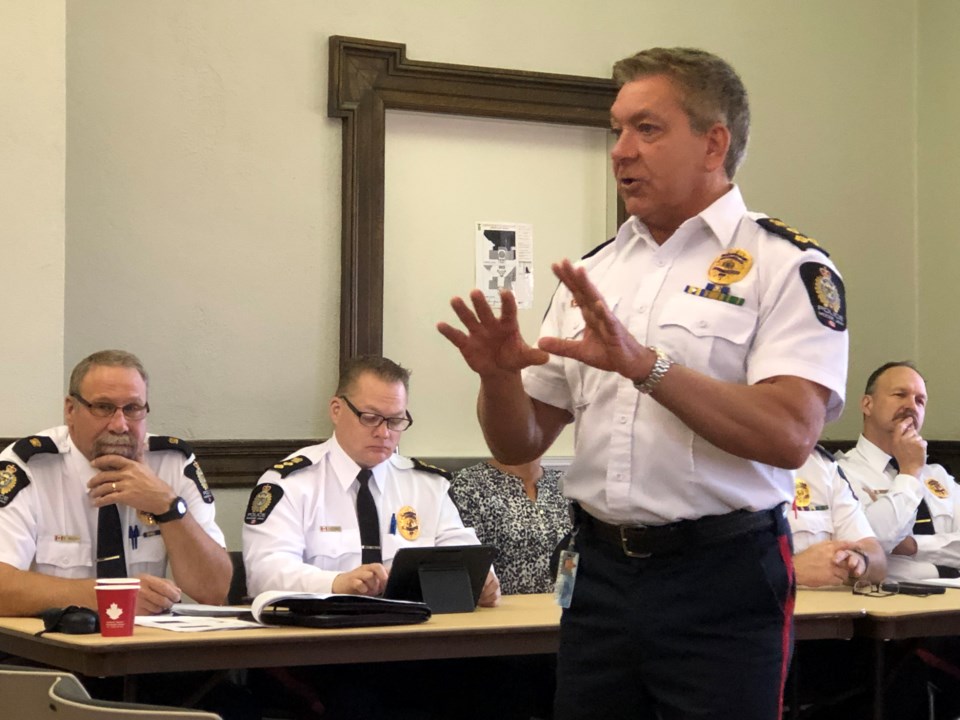There was a sharp increase in crime in Moose Jaw in 2016 compared to 2015, which the police chief mainly attributes to illegal drugs in the community.
“Much of the crime is people getting money to keep that drug use moving forward,” said Police Chief Rick Bourassa. “We watch these data very closely. We get down into the details of it and we use it to shape some of our enforcement activities.”
In 2013, the number of Criminal Code incidents here was 2,957, according to data from the Moose Jaw Police Service. That number increased to 3,098 two years later, before jumping to 3,803 in 2016. The number of incidents then decreased to 3,364 two years ago.
Numbers for last year were unavailable.
The Board of Police Commissioners and police force held an open house at the Moose Jaw Public Library on May 7 to give residents a better idea of the services the organization provides in the community. More than 40 residents learned about the force’s priorities and initiatives, the K-9 unit, the child abuse investigative team, and a police and crisis team.
Size of the police force
There were 57 police officers patrolling Moose Jaw last year, a number that has remained steady since 2012. Furthermore, based on 2016 data, each police officer responds to 70 Criminal Code incidents.
“Aside from Prince Albert (83 incidents per officer), Moose Jaw officers carry a very heavy workload,” said Bourassa. “Our members are busy.”
Calls for service
The number of calls for service the police force has received since 2014 has consistently hovered around 16,000, said Bourassa. In 2014 there were 16,432 calls for service, while last year there were 15,642 calls.
Moose Jaw has a crime rate that is similar to communities such as Regina and Saskatoon. A provincial formula has determined that Prince Albert had the highest crime rate in 2017, at 19,783, compared to Moose Jaw (9,679), Saskatoon (9,580) or Regina (9,067).
“That (number) surprises people, because there is a bit of a notion that Moose Jaw is a quiet place and not much happens,” said Bourassa. “No, that’s not true. We have similar issues here as elsewhere.”
Crime Severity Index
The Crime Severity Index (CSI) refers to a measure of police-reported crime that reflects the seriousness of individual offences, tracks changes in crime severity and gives a weighted rating to each incident. For example, a minor theft could be rated a one and a murder could be rated 1,000.
Based on 2017 data, Moose Jaw’s CSI rating was 108. In comparison, Prince Albert had a CSI of 251; Saskatoon’s CSI was 127; and Regina’s was 117.
“As a police service, we need to make sure we’re working on those issues,” Bourassa said. “It tells us indirectly that much of what we deal with is connected with other places ... People who are involved in situations — that doesn’t stop at the border.”
Moose Jaw’s CSI rating fluctuated from 91 five years ago to 116 three years ago. The police force knows this is due to drugs, particularly crystal meth.
The force is also seeing a shift in societal values, Bourassa continued. The municipality’s violent CSI rating was 73 two years ago, 84 three years and 45 in 2013. This shows that physical aggression, property crime, assaults and violence appear to be a more acceptable way to solve problems than in the past.
“We watch these things and we recognize there are some issues we have to deal with,” he added.




